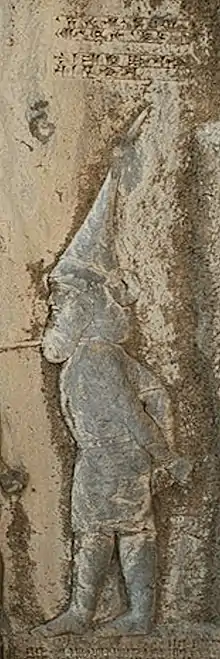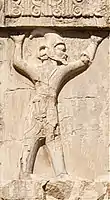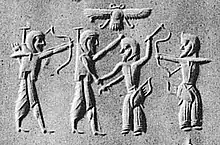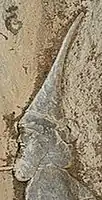Skunkha
Skunkha (Old Persian: Skunxa-),[2] also written as Skunxa or Skuka, was king of the Sakā tigraxaudā ("wearing pointed caps Saka,") a group of Scythians, in the 6th century BC.
| Skunkha | |
|---|---|
| King of the Sakā tigraxaudā | |
 Behistun relief of Skunkha. Label: "This is Skunkha the Sacan."[1] | |
| Reign | 6th century BC |
Capture
In 519 BC, Darius I of Achaemenids attacked the Saka tribe and captured their king. His capture is depicted in the relief sculpture of Behistun Inscription, last in a row of defeated "lying kings".[3] After his defeat, Darius replaced him with the chief of another tribe.[4]
King Darius says: Afterwards with an army I went off to Scythia, after the Scythians who wear the pointed cap. These Scythians went from me. When I arrived at the river, I crossed beyond it then with all my army. Afterwards, I smote the Scythians exceedingly; [one of their leaders] I took captive; he was led bound to me, and I killed him. [Another] chief of them, by name Skunkha, they seized and led to me. Then I made another their chief, as was my desire. Then the province became mine.
Related depictions
References
- Behistun, minor inscriptions DBb inscription- Livius.
- Schmitt, Rüdiger (2018). "MASSAGETAE". Encyclopaedia Iranica.
- Rolle, Renate (1 July 1992). The World of the Scythians. University of California Press. p. 47. ISBN 978-0520068643.
- M. A. Dandamayev (1999). History of Civilizations of Central Asia Volume II: The development of sedentary and nomadic civilizations: 700 BC to AD 250. UNESCO. pp. 44–46. ISBN 978-8120815407.
- Hartley, Charles W.; Yazicioğlu, G. Bike; Smith, Adam T. (2012). The Archaeology of Power and Politics in Eurasia: Regimes and Revolutions. Cambridge University Press. p. 83. ISBN 9781107016521.


